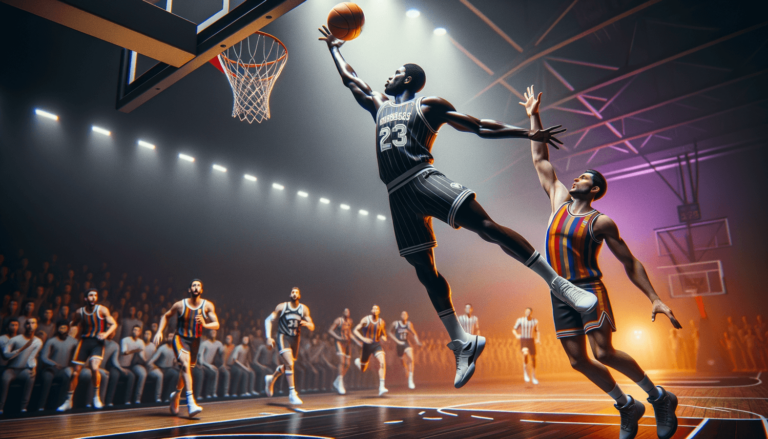
Welcome to the world of basketball, where the game never stops being thrilling and the plays can range from awe-inspiring dunks to crafty, strategic moves. For enthusiasts craving the inside scoop on one of basketball’s slickest shots, you’ve come to the right place! Today, we’ll delve into the depths of the elusive and enigmatic “floater.” This high-arcing, off-balance shot is seen as a go-to option for some of the game’s greatest guards, combining finesse, skill, and an almost mysterious beauty. Whether you’re looking to elevate your own game or simply indulge your curiosity, prepare to be swept off your feet by this in-depth exploration of the art that is – the floater.
What’s a Floater in Basketball?
A floater in basketball is a one-handed, high-arcing shot usually executed by guards. The player drives towards the hoop, jumps off one foot, and releases the ball with a quick, soft touch while floating in mid-air. This shot is effective in avoiding shot-blockers and navigating through tight defenses, making it a valuable weapon in a player’s offensive arsenal.
The Genesis of the Floater
While it’s difficult to pinpoint the exact origin of the floater, many believe it can be traced back to the early days of basketball, when players often utilized an underhand shooting technique. Over time, as the game evolved and became more focused on athleticism and speed, the floater transformed into the stylish, high-arcing shot we see today. In this modern era of basketball, it has become an indispensable (and some would say, unstoppable) weapon for penetrating guards who need to score in confined spaces.
Breaking Down the Floater’s Mechanics
With the ability to maintain a level of elegance in the face of ferocious defenders, the floater’s magic lies in its precise mechanics. Let’s dissect these essential components that make the shot both effective and enchanting:
Footing and Balance
A successful floater begins with a firm foundation, as the player drives towards the hoop and plants one foot firmly on the ground. The majority of players will jump off their dominant foot – for instance, right-handed players typically leap off their left foot. The foot placement, combined with a powerful push off the ground, helps to maintain balance and stability throughout the shot.
Jump and Release
The player explodes off the ground, relying on their body’s forward momentum to transition into a vertical leap. As they reach the peak of their jump, they bring the ball up with one hand, extending their shooting arm, and release the ball with a quick flick of the wrist. This swift, fluid motion imparts a gentle backspin on the ball, allowing it to arc gracefully through the air and over the outstretched hands of defenders.
Follow-Through and Touch
Just as crucial as the initial push off the ground and the release of the shot is the follow-through. The player’s shooting hand should follow the natural arc of the ball, finishing with a slight outward extension to help guide its trajectory. The key is to have a soft touch at the rim, allowing the ball to fall gently through the net and minimize the chances of a hard bounce off the backboard or rim.
Mastering the Floater’s Rhythm
Every player has a unique shooting rhythm, and the floater is no exception. The key is to find and perfect your personal rhythm when executing this shot so that it becomes second nature. Here are some tips to help you discover and cultivate your own floater rhythm:
Repetition
As with any skill in basketball or otherwise, practice makes perfect. Dedicate time to practicing your floater in various game-like situations – approaching the basket from different angles, adjusting your speed, and navigating through traffic. Over time, you’ll develop the muscle memory and confidence needed to transform it into a reliable scoring option.
Embrace the In-Between
Floating shots are often referred to as “in-between” shots because they’re taken from mid-range distances and nestled between a layup and a jump shot. Embrace this middle ground and learn to gauge the perfect distance to release your floater. By mastering this zone, you’ll increase your ability to consistently knock down floaters with precision.
Visualize Success
Visualization can be a powerful tool in refining your floater. Envision the shot’s successful outcome in your mind’s eye – see the ball soaring through the air and swishing through the net. Let this mental image guide your practice sessions and fuel your confidence during games.
Utilizing the Floater in Various Game Situations
The true beauty of the floater manifests when players weave it seamlessly into various offensive situations. Here are some scenarios where a well-executed floater can be a game-changer:
Attacking Shot-Blockers
Players driving into the paint often find themselves thwarted by towering shot-blockers. The floater swoops in like a superhero, providing a crafty and unexpected way of scoring over and around these defensive giants. With its high arc and soft touch, the shot becomes difficult to block, leaving opponents frustrated and your team rejoicing.
Probing Tight Defenses
When facing an aggressive defense, players often find it challenging to create clean looks at the basket. The floater’s unique trajectory allows players to navigate through small gaps in the defense, rise above the fray, and release the shot before the opposition has a chance to react.
Exploiting Mismatches
Mismatches occur when players find themselves guarded by a less agile or less experienced defender. Cunning guards can capitalize on these mismatches by using the floater to bewilder their defender, ultimately creating scoring opportunities for themselves and their teammates.
Famous Practitioners of the Floater
Over the years, numerous basketball luminaries have showcased their mastery of the floater, with each one adding their unique flair to this finesse-driven shot. Here’s a look at a few of the most notable floating artists:
Tony Parker
Considered by many to be the chief maestro of the floater, Tony Parker’s ability to execute this shot with panache and precision allowed him to succeed as a smaller guard in the NBA. The Frenchman’s legendary “teardrop” has inspired countless basketball players, solidifying the floater’s status as an essential skill.
Stephen Curry
Beyond his lauded three-point shooting prowess, Stephen Curry possesses an arsenal of offensive weapons, including the floater. Curry’s ingenuity with the shot has taken it to new heights, blending his quickness and touch to create an unstoppable offensive force.
Kyrie Irving
Unpredictable and creative, Kyrie Irving’s nimble footwork and smooth hang-time enable him to fire off highly effective floaters. Merging his artistry and skill, he leaves defenders bewildered as his shot hovers through the air and dances into the hoop.
Adding the Floater to Your Game
Equipped with the knowledge of the floater’s mechanics, rhythm, and versatility, it’s time for you to take this remarkable shot to the court. With dedication, practice, and visualization, you can develop your own version of the floater, tailored to your unique style and skills. Remember, the journey to become a floating aficionado begins by embracing the momentum, touch, and finesse that define this captivating shot. Soon enough, you’ll be floating through the air and connecting with that swish, adding a new layer of magic to your basketball game.
Essential Drills for Practicing the Floater
Having the right drills to hone your floater will make all the difference in your progress. To develop a consistent, game-ready floater, consider incorporating these useful exercises into your training regimen:
One-Step Floater Drill
This basic drill allows you to focus on the footwork and balance required for a successful floater. Start near the baseline, take one step in towards the hoop with the foot opposite your shooting hand, then jump off that foot and attempt a floater. Repeat this drill, alternating your approach angle and gradually increasing your speed.
Three-Dribble Floater Drill
This drill simulates game-like conditions, teaching you to quickly transition from dribbling to executing a floater. Begin outside the three-point arc with a basketball, take three hard dribbles towards the basket, then jump off one foot and shoot the floater. This drill will help you develop a sense of timing and make the process more fluid.
Finishing at the Rim Drill
This drill challenges your touch and accuracy when shooting the floater close to the rim. Beginning just outside the key, take a few dribbles towards the basket before leaping off one foot and attempting to make a floater. The objective is to make the shot without hitting the backboard or rim, refining your touch and control.
Defender on the Hip
The presence of an actual defender can elevate your floater training. Enlist a teammate or coach to act as a defender, simulating game-like pressure as you drive towards the hoop. This will help you grasp when and where to release the floater amidst traffic, and increase your comfort level during real games.
Floater Variations and Cousins
The game of basketball is rife with creativity and innovation, and the floater is no exception. A number of variations and similar shots have emerged over time, providing players with even more tools for bewildering defenders:
Subtle Finger-Roll
The finger-roll is a close relative of the floater and can also deceive defenders. To execute this shot, approach the basket and extend your arm towards the hoop while releasing the ball with a gentle roll of the fingers. The ball should softly roll off the fingertips and into the basket – an effective, albeit showy shot that leaves fans and opponents in awe.
Jump Hook Floater
An unconventional blend of the jump hook and the floater, this hybrid shot requires players to leap into the air and, at the peak of their jump, release the ball with a hook shot motion. The high arc can render the shot unblockable, making it a surprise tool in a player’s offensive toolkit.
Ambidextrous Floaters
For advanced players, the ability to execute floaters using either hand can be a significant advantage. Being ambidextrous while shooting floaters makes you unpredictable and difficult to defend, keeping your opponents on their toes.
Recognizing When Not to Floater
While the floater is an undeniably impressive shot, it’s important to acknowledge that it’s not appropriate for every situation. Being aware of when not to resort to the floater is just as vital as knowing when to use it:
Open Jump Shots
When faced with an open jump shot opportunity, it is generally more efficient to take the jumper rather than drive towards the rim and attempt a floater. Jump shots are more statistically reliable and consume less energy, making them the smarter choice in such situations.
Double-teamed Drives
When driving into the paint and attracting a double team, using a floater isn’t always the most effective choice. Instead, consider dishing the ball to a wide-open teammate who has a better look at the basket, creating higher-percentage scoring chances for your team.
Early Shot Clock
During the early ticks of the shot clock, patience is key. Taking a floater when better options are likely to emerge later in the possession can be detrimental to the team’s offensive success.
By understanding the limitations and nuances of the floater, you’ll be better equipped to use this shot judiciously and in harmony with your overall offensive strategy. So go forth, and let your floaters fly!
Frequently Asked Questions
Here’s a roundup of frequently asked questions that explore different aspects of the floater in basketball. This FAQ section will help enrich your understanding of the shot and address any lingering queries you may have about this skillful play:
1. Why is it called a floater?
The shot is called a floater because, during the execution, players appear to briefly “float” in the air as they release the ball. The high-arcing trajectory of the shot also gives the impression that the ball is floating through the air towards the basket.
2. Who invented the floater in basketball?
There is no definitive answer as to who exactly invented the floater, but it has its roots in the early days of basketball, evolving from the underhand shooting technique that was once prevalent in the game.
3. How can I improve my floater?
You can improve your floater by consistently practicing drills that focus on footwork, balance, timing, and accuracy. Also, develop your timing and touch by gauging distances, and visualize successful outcomes to build confidence in your shot.
4. Is a floater a high-percentage shot?
A well-executed floater is generally considered a high-percentage shot, particularly for smaller guards driving into the basket against taller defenders. However, it may not be as reliable as a layup or an open jump shot in certain situations.
5. What is the difference between a floater and a runner?
A floater and a runner are often used interchangeably, but there is a subtle difference between the two. A floater has a higher arc and is typically released with a soft fingertip touch, while a runner is more of a traditional one-handed, running jump shot with a lower arc.
6. How can I defend against a floater?
Defending against a floater requires anticipation, quick lateral movement, and proper positioning. It’s essential to stay close to the offensive player, avoid fouling during the shot attempt, and try to contest the shot without leaving your feet, as jumping exposes you to the risk of being outmaneuvered.
7. Can tall players use the floater effectively?
While the floater is commonly used by smaller guards, taller players can also develop and effectively utilize the shot to their advantage. The floater can serve as an unexpected scoring option for these players, catching defenders off guard.
8. Do left-handed players have a different technique for shooting a floater?
Left-handed players generally have a mirrored technique for shooting a floater when compared to right-handers. Left-handed players will usually plant their right foot on the ground and release the ball with their left hand, following the same principles of rhythm, control, and touch as their right-handed counterparts.
9. Can the floater be executed with two hands?
While the floater is typically a one-handed shot, players can experiment with a two-handed variation. However, the one-handed version is often preferred due to its quicker release and better control in tight spaces.
10. When should I choose a floater over a layup?
Choosing a floater over a layup is advisable when encountering a shot-blocker or when taking an in-between shot from mid-range distances. The floater’s high arc and quick release make it a valuable tool for scoring over taller defenders and exploiting gaps in the defense.
11. What are the most effective drills to practice floaters?
Efficient drills for practicing floaters include the one-step floater drill, three-dribble floater drill, finishing at the rim drill, and working with a defender on the hip. These exercises help improve footwork, balance, timing, accuracy, and touch while simulating game-like pressure.
12. Can a floater be blocked?
While a floater can be challenging to block due to its high arc and quick release, it’s not impossible. Alert defenders with good anticipation skills and timing can successfully block or contest floaters.
13. Why do some NBA players struggle with floaters?
Some NBA players may struggle with floaters due to a lack of practice, improper technique, or discomfort with the shot’s unique mechanics. The key to mastering the floater lies in consistent practice, refining technique, and developing a personal rhythm and touch that works for the individual player.
Featured Posts
- No pillar pages found.




